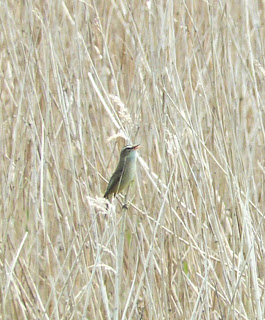After a good night's sleep, it was up at 7.30 am for breakfast at 8 am. A lie in! I love these "at leisure" trips.
 |
| View from my balcony (shame the pool was empty! |
Breakfast, taken on the terrace overlooking the sea was a relaxed affair with bread, jam, honey for the traditionalists and cucumber, red pepper, sliced meat and cheese with olives for the more adventurous. I (needless to say) sampled it all - yes Heather and Nicky, even the olives - still don't like them.
Today we were off to the famous bird haven of the Goksu Delta for lots of water birds. In Tasucu two white storks had set up home on top of the local clock tower in the middle of the town square, with one bird already on the nest, a second flew in above our heads as we drove past.
 |
| The South Hide |
As the name suggests the Goksu Delta is a large area of water, marsh, reed beds and sand, with tidal areas, brackish lagoons and is a large flat area which is difficult to see over especially with a heat haze. Luckily there was a hide set up in a tower which gave us great views and for the rest we utilised the banks of earth and gravel to gain some overview.
Lunch was picnic style, and we took the day in relaxed style moving along in our two vehicles birding as we went and stopping every now and then to get better views or search out species. At one stage we stopped to check out some plants in a boggy area; bug orchids and bog asphodels - to name but two, we had a great time picking over the various species.
 |
| Little Bittern |
In the course of the day I managed to add five new birds to my life list, but overall the group saw over 100 species. Amongst the most numerous were ruddy shelduck, western marsh harrier, Kentish plover, spur-winged lapwing, ruff, over 70 slender-billed gulls, yellow legged gull, little, white-winged black,sandwich and common terns, crested lark, common swift, house martin, thrush nightingale, white-spectacled bulbul, lesser grey shrike and red-backed shrike.
 |
| Lemon-green European Tree Frog |
Seen on a lesser scale were northern shoveler, eurasian teal, garganey, red-crested pochard, black-necked and great-crested grebes, common crane, squacco heron, little egret, great egret, grey heron, purple heron, white stork, glossy ibis, eurasian spoonbill, greater flamingo, common kestrel, eurasian oystercatcher, stone curlew, collared pratincole, little ringed and common ringed plover, grey plover, curlew sandpiper, little stint, common sandpiper, wood sandpiper, common redshank, eurasian curlew, whimbrel, black-headed gull, black tern, caspian tern, eurasian collared dove, eurasian turtle dove, laughing dove, alpine swift, European roller, common skylark, sand martin, barn and red-rumped swallow, common nightingale, common redstart, northern wheatear, whinchat, barred warbler, blackcap, lesser whitethroat, European reed warbler, a tail-less willow warbler, common chiffchaff, spotted flycatcher, woodchat, isabelline and masked shrike, common raven, house, Spanish sparrow and a rather washed out female - possibly dead sea sparrow, european goldfinch and greenfinch and corn bunting.
 |
| Beetle in Bug Orchid |
Phew what a list! More to come though . . .
Finally the birds which thrilled me the most - black francolin, little bittern, broad-billed sandpiper, lesser sand plover, greater short-toed lark, yellow wagtail - here the black-capped version feldegg, black-eared wheatear and black-headed bunting.
So with a long list for the day, it was back to the hotel for dinner and then off to bed . . . to dream of what awaits us tomorrow





















































